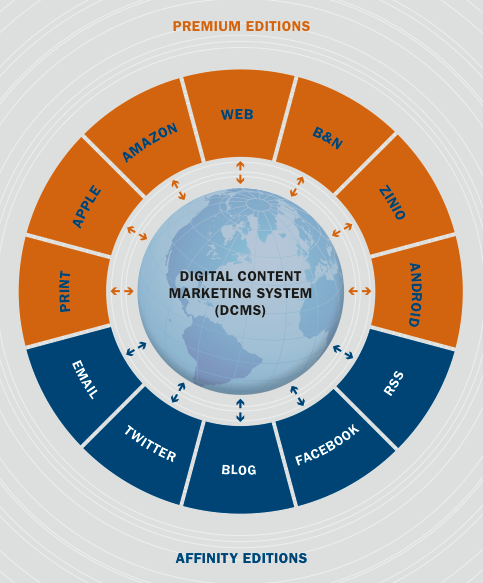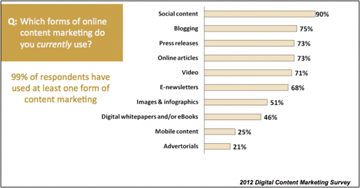Digital content marketing drives surge in digital product sales for publishers
While many organizations have discovered the power of digital content marketing to sell products and services, perhaps no organizations are being impacted like the publishers of books, magazines, newsletters and videos.
Digital content marketing for publishers
Publishers, like most marketers, have traditionally used marketing copy and paid media to sell their books, magazines, newsletters, videos and other premium information products. It should come as no surprise that digital content marketing is having a profound impact on the publishing industry. For publishers, content marketing has a double meaning. Publishers would tell you they’ve always been content marketers or marketers of content. Today, content marketing has taken on the additional meaning of using content to sell products and services of all types. Savvy publishers have been quick to figure out that, as producers of premium content, they have a ready source of free content to use for content marketing.
The digital content marketing system
The attached diagram shows a fully integrated digital content marketing system that might be used by a book, magazine, newsletter, video or multiplatform publisher. It illustrates the simple concept that minimum information units are produced in a variety of formats for distribution as both free and premium content. Premium content channels include legacy print distribution, plus the myriad of retail stores attached to digital tablets and traditional computers. For most publishers of large-format media that’s designed to be read, tablets and computers are the primary premium distribution channels. The diagram goes on to illustrate the most prominent channels for free content distribution.

The new content marketing
While our Mequoda Method teaches this integrated strategy to content producers, many other digital content marketing systems exist for producers of non-content premium products, from automobiles to airline tickets and wine to whiskey. The Internet has made content distribution via affinity channels so cheap that everyone is embracing digital content marketing as a core marketing strategy. For publishers, this brings increased pressure to make sure that our free content is better than most. In our experience, being a producer of premium content is both a blessing and a curse. On the one hand, it provides an amazing source of original content from which we can spin free content. On the other hand, it’s often difficult to decide what to charge for and what to give away for free.
Digital content marketing trends for 2013
A survey of our 25 gold member clients who sell premium content reveals that digital book publishing and digital newsletter publishing are benefiting most from the trend to digital distribution. While you might be quick to assume that the Kindle was the driving factor here, our publishers report that their digital book publishing efforts are seeing the most success when powered by their own web-based retail stores. Sales from Amazon, Apple and others are lagging behind direct to consumer sales. Our digital newsletter publishers rely almost totally on their own subscription websites for sales as many are just now venturing into the third-party stores run by the major tablet computer manufacturers.
Video sales rank next in terms of digital distribution. Once again, our premium digital video producers tell us that virtually all of their sales are coming from their own web-based retail stores.
While digital magazine publishing is all the buzz, our publishers report that it’s a lagging indicator with as little as 10 percent of total sales coming from partners like Apple and Amazon in 2012. Most expect that number to double for 2013 as the tablet base continues to expand and they become more adept at using digital content marketing to drive digital content sales and launch their own subscription websites.
[text_ad]
What is good digital content marketing?
Our colleagues at the Content Marketing Institute published a survey earlier this year that offers some great suggestions on how to create engaging digital content marketing campaigns. Use these tips to power your affinity content programs.
The Content Marketing Institute’s content marketing survey shares the opinions of 389 marketing professionals. Out of all respondents, 99 percent reported using at least one form of content marketing.
Social content topped the list, with 90 percent of respondents citing it as a current strategy. With large social networks (Facebook, LinkedIn, Twitter, and Pinterest) and heavy interactivity, it’s not surprising that social content is a priority. With engagement through all age demographics, and the ability to interact with mobile devices, presence on social media has never made more sense to online marketers.

Blogging and press releases were cited as the second and third most used digital content marketing techniques. Both utilize the hybrid approach to content marketing where editorial and promotional content are closely aligned.
The most important elements of content
The survey’s data names six main elements of content desired by marketing professionals. These elements are listed below in order of importance, according to the 84 percent of respondents who outsource content creation:
Element of engaging content #1: Engaging and creative storytelling
Element of engaging content #2: Crafted custom content
Element of engaging content #3: Professional-level writing
Element of engaging content #4: Well-edited content
Element of engaging content #5: Copy written for SEO
Element of engaging content #6: Originality
Do these elements of engaging content resonate with your content marketing expectations? Do you focus on these elements while creating content? Please share your thoughts in the comments below.
—–
Mequoda Managing Editor Chris Sturk contributed to this article.
—–
Originally published 09/16/2012


